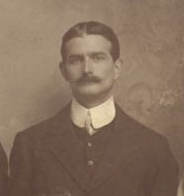
S3722
PALMER, Harry Brittlebank
| Service Number: | 5127 |
|---|---|
| Enlisted: | 27 March 1942, Adelaide, SA |
| Last Rank: | Sergeant |
| Last Unit: | 32nd Infantry Battalion |
| Born: | Leicester, England, 10 May 1882 |
| Home Town: | Adelaide, South Australia |
| Schooling: | Not yet discovered |
| Occupation: | Store Keeper |
| Died: | Natural causes, Adelaide, South Australia, 4 August 1954, aged 72 years |
| Cemetery: |
Mitcham Anglican Cemetery, South Australia |
| Memorials: |
World War 1 Service
| 22 Dec 1917: | Involvement Sergeant, 5127, 32nd Infantry Battalion, --- :embarkation_roll: roll_number: '17' embarkation_place: Melbourne embarkation_ship: HMAT Ulysses embarkation_ship_number: A38 public_note: '' | |
|---|---|---|
| 22 Dec 1917: | Embarked Sergeant, 5127, 32nd Infantry Battalion, HMAT Ulysses, Melbourne |
World War 2 Service
| 27 Mar 1942: | Enlisted Adelaide, SA |
|---|
Help us honour Harry Brittlebank Palmer's service by contributing information, stories, and images so that they can be preserved for future generations.
Add my storyBiography
Sergeant Harry Brittlebank Palmer was an Australian soldier born in England, who made the journey over to England and France to fight in World War 1. He was born in Leicester, England on the 10th May 1882 before later travelling to live in Australia. Harry was a store keeper before World War 1, but when he enlisted for World War 2, he had changed occupation to a gardener.
Harry was a store keeper before the war, and signed up for the AIF (Australian Imperial Forces) on the 16th of February 1917, in Adelaide. He was 173 cm tall, and weighed 58 kg, so he was a small man. He had brown hair and grey eyes. Sergeant Palmer was viewed as enlisting quite late, as the war ended at the later stages of 1918. Many soldiers would have signed up in 1914 and 1915, due to high pressure from the general public. Sergeant Palmer signed up at 42 years and 9 months old.
Sergeant Palmer was given the rank of Sergeant, and the service number 5127, and he was placed into the 14th Reinforcement of the 32nd AIF Infantry Battalion. The colour patch for the 32nd Battalion was rectangular, and the left half of the patch was white, while the right side of the patch was yellow.
Harry left for England after training at Mitcham. He left on the HMAT Ulysses from Melbourne on the 22nd of December 1917, and eventually arrived in Egypt, in the Suez Canal, for further combat training. Soldiers would not have spent all of their time training, however, and some popular pastimes included writing letters, stories and poems, as well as creating artworks and playing games, usually cards.
After the training Sergeant Palmer was described as being very proficient with a rifle, whilst also having a ‘fair working knowledge of a Lewis gun’, which was a fairly large machine gun which could shoot 800 metres. Sergeant Palmer then left for England.
Sergeant Palmer arrived at Southampton on the 15th of February 1918, almost 1 full year after he signed up. Once he arrived in England, he fell sick and was taken to Tidworth Military hospital, just north of Southampton. Harry was at hospital for 11 days with influenza.
Sergeant Palmer spent another year in England and France, but there is no record of him fighting on the front line. His battalion was involved in big fights while he was in France, such as the Battle of Amiens, in which there were around 44,000 Allied casualties and 75,000 German casualties. The Battle of Amiens was widely regarded as one of the fights that tipped the war in the Allies’ favour.
Harry had a physical condition known as albuminuria while he was at war. He had the condition before he went to war, and in some ways it was aggravated by military service. Albuminuria is a condition where parts of the blood plasma, known as albumin but generalised as protein, leak into the urine usually due to failure of the kidneys. Albuminuria can also cause pain in the limbs, and can be one of the first symptoms of kidney disease. The condition caused him pain in his legs and specifically his right ankle, which kept him away from the front lines. He was eventually sent home on the ‘Morvada’, on the 14th of March 1919. Sergeant Palmer received 3 medals after his service: the Star, the British War Medal and the Victory Medal. These were common awards given to those soldiers who survived the war.
Sergeant Palmer also enlisted for World War 2, even though he was much older than most of the soldiers there. He was part of the army for 1.5 years during World War 2, and did not fight on the front line, as he was already at least 59 years old when he enlisted.
There were many ways Sergeant Palmer displayed true ANZAC spirit. ANZACs were widely regarded as being courageous, humble, determined, brave and also had a great sense of national pride. Sergeant Palmer had injuries and illnesses from before the war, and was quite old compared to some other soldiers, but signed up regardless so that he could try his hardest to be a part of Australia’s war effort. Signing up for World War 2 also showed this ANZAC Spirit, as it showed that those who survived the first war had the bravery to go back to the fighting once again.
Sergeant Palmer died of natural causes on the 4th of August, 1954, at the age of 72. He was a good soldier who demonstrated all the true ideals of an Australian soldier and showed true ANZAC spirit.












